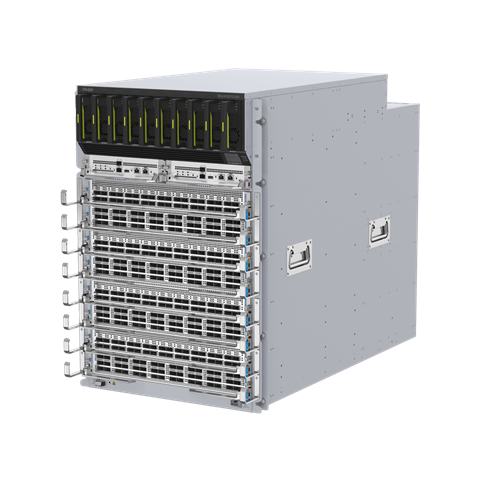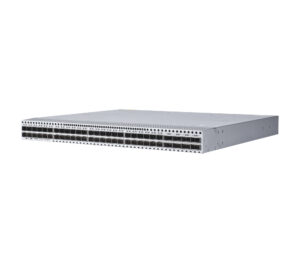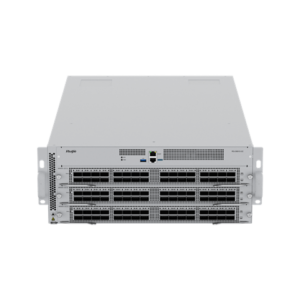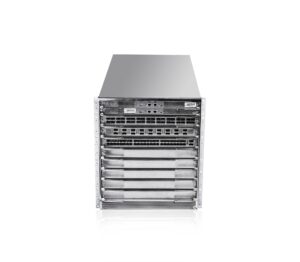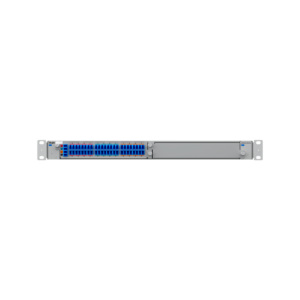Hardware Specifications
| System | RG-N18010-XH |
| Switching Capacity | 230.4Tbps |
| Packet Forwarding Rate | 43200 Mpps |
| Slots | RG-N18010-XH |
| Module Slots | 10 (2 for supervisor modules) |
| Switch Fabric Module Slots | N +1 redundancy |
| Expansion Module Slots | 10 power supply module slots, supporting N+M redundancy
3 fan module slots, supporting 2+1 redundancy |
| Dimensions and Weight | RG-N18010-XH |
| Dimensions (W × D × H) | Chassis excluding the cable management bracket: 442 mm × 896 mm × 708 mm, 16 RU
Chassis including the cable management bracket: 442 mm × 935 mm × 708 mm, 16 RU |
| Weight | 94.15 kg (including the fan) |
| Power Supply and Consumption | RG-N18010-XH |
| Power Supply | RG-PAH3000I-F:
● AC: 100 VAC to 176 VAC, power: 1500 W ● AC: 176 VAC to 240 VAC, power: 3000 W ● HVDC: 240 V DC to 380 V DC, power consumption: 3000 W |
| Maximum Power Consumption | 19000 W |
| Environment and Reliability | RG-N18010-XH |
| MTBF | > 692,000 hours |
| Operating Temperature | 0°C to 40°C |
| Storage Temperature | –40°C to 70°C |
| Operating Humidity | 10% to 90% RH (non-condensing) |
| Altitude | ● Operating altitude for long-term working conditions: up to 5000 m. At 1800 m, the maximum operating temperature is 40°C. The maximum operating temperature decreases by 1°C per 200 m increase in altitude.
● Operating altitude: up to 5000 m ● Storage altitude: up to 5000 m |
Software Specifications
| Software Specifications | RG-N18010-XH |
| Traffic Analysis | sFLOW
IPFIX |
| L2 Features | Jumbo frame
IEEE 802.3ad (static link aggregation, LACP, cross-card link aggregation, cross-device link aggregation) IEEE 802.1Q STP, RSTP, MSTP GVRP QinQ LLDP Static MAC addresses, address filtering, and limit on the number of MAC addresses |
| IPv4 Features | Static routing, RIP, OSPF, IS-IS, and BGP4
VRRP ECMP Policy-based routing Manual tunnel and GRE tunnel |
| IPv6 Features | Static routing, OSPFv3, BGP4+, IS-ISv6, and MLDv1/v2
VRRPv3 ECMP Policy-based routing Path MTU Discovery Manual tunnel and GRE tunnel Pingv6, telnetv6, FTPv6, TFTPv6, DNSv6, ICMPv6 |
| Multicast | IGMP v1/v2/v3
IGMP snooping IGMP proxy PIM-DM, PIM-SM, PIM-SSM, and other multicast routing protocols MLDv1, MLDv2 Multicast static routing Fast leave |
| ACL | Standard, extended, and expert-level ACLs
Global ACLs Ingress/Egress ACLs IPv6 ACLs |
| QoS | Mapping of IEEE 802.1p, DSCP, and ToS priorities Priority marking/remarking Multiple queue scheduling mechanisms, including SP, WFQ, SP+WFR, Congestion avoidance mechanisms such as RED and WRED Port-based rate limit |
| Reliability | Independent switch fabric modules and independent supervisor modules to implement thorough separation of the forwarding plane from the control plane
1+1 redundancy for supervisor modules N+1 redundancy for switch fabric modules N+M redundancy for power supply modules and fans Backplane-free design to avoid single point of failures Hot swapping of components Hot patch function and online installation of patches BPDU Guard/Loop Guard/Root Guard NSR DLDP FRR GR for OSPF/IS-IS/BGP BFD for VRRP/OSPF/BGP4/ISIS/ISISv6/static routing |
| Security | MacSec
Network Foundation Protection Policy (NFPP) and CPU protection policy (CPP) to prevent protocol packet attacks Prevention against DDoS, ARP, and ICMP attacks DAI, port security, IP source guard, and port protection uRPF RADIUS and TACACS user login authentication, password security, hierarchical user management, and password protection Source IP address restriction Function of not sending unknown multicast packets to the CPU Suppression of unknown multicast, unknown broadcast, and unknown multicast packets SSHv2, providing encrypted security channels for user login Plaintext and MD5 ciphertext authentication for OSPF, RIPv2, and BGP4 packets |
| Management | Console/AUX Modem/Telnet/SSH2.0 CLI configuration
FTP, TFTP, Xmodem, and SFTP SNMP V1/V2c/V3 NETCONF RMON NTP clock Fault alarm and auto-recovery System operation logging Traffic analysis Zero-touch provisioning (ZTP) Reliable network service (RNS), which probes specific services provided by the peer device to monitor the service availability Telemetry Buffer status monitoring and traffic microburst identification Port mirroring, traffic mirroring, and ERSPAN Physical ports on all line cards support the routing mode and IP addresses can be configured independently. Monitoring of fan modules and power supply modules |

